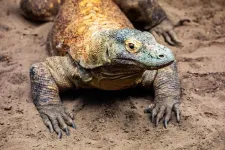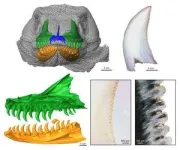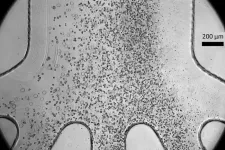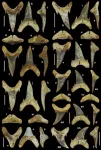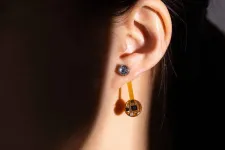(Press-News.org) Tea Maho and Robert R. Reisz
University of Toronto Mississauga
Kilat, the largest living lizard at the Toronto Metro Zoo, like other members of his species (Varanus komodoensis), truly deserves to be called the Komodo Dragon! Its impressive size and the way it looks at you and tracks your every move makes you realize that it is an apex predator, not unlike a ferocious theropod dinosaur. So, it is not surprising when you look around at his enclosure to find that there are shed teeth sparkling on the ground, a common find when hunting for Mesozoic theropod dinosaurs. This startling phenomenon led us to study the teeth and feeding behaviour of this fascinating predator. The Toronto Zoo Team generously collected many shed teeth and allowed us to undertake this study, and skulls in the skeletal collection of the Royal Ontario Museum were also made available to us.
Previous studies have focused on the unique feeding behaviour of the Komodo Dragon but have not related this to its unique dental morphology, development, and replacement. We, therefore, examined the dentition and jaws of adults and juveniles with a combination of histological analysis and computed tomography (CT). We discovered that the adult Komodo teeth were surprisingly similar to those of theropod dinosaurs, with the strongly recurved teeth of adults having serrated cutting edges that were strengthened by dentine cores. “We were very excited by this discovery because it makes the Komodo an ideal living model organism for studies of the life history and feeding strategies of the extinct theropod dinosaurs” said PhD student Tea Maho, lead author of the paper published in PLoS One.
The Komodo Dragon, like most other reptiles, including the extinct theropod dinosaurs, replaces its teeth continuously throughout its life. The histology, a common technique for studying the microstructure of teeth, and x-ray CT of their heads showed that the Komodo dragon maintains up to five replacement teeth per tooth position in their jaws. “Having this many teeth within the jaw at a given time is a unique feature among predatory reptiles, and only seen In the Komodo” noted Dr. Robert Reisz, coauthor of the research paper. Most other known reptiles have one or at most two replacement teeth in the jaw, and this includes most theropod dinosaurs. Perhaps the most surprising discovery was that the Komodo started to make new teeth in each tooth position every 40 days. This is why there were so many shed teeth in the Komodo Dragon enclosure, and this is how new teeth very rapidly replace the old functional teeth. Other reptiles, including most theropod dinosaurs, usually took three months to make a replacement tooth, sometimes as long as a year. “So, if in the wild a tooth breaks during prey capture or defleshing, no problem, a new one would replace the broken tooth very quickly” explained Tea Maho.
Since we had skulls and teeth of both adults and juveniles of the Komodo, we were also able to discover an interesting correlation between their teeth and their feeding behaviour. Hatchlings and juvenile Komodos have more delicate teeth, not suited for the typical defleshing behaviour of the adults, and spend most of their time in the trees, avoiding the adults and feeding mainly on insects and small vertebrates. As they grow to adult size, their teeth change dramatically in shape, and they eventually descend from the trees to become apex predators, able to attack and kill anything in their domain.
Finally, we also noticed that the front teeth of the Komodo adults are either very small or completely missing. This unusual dental morphology correlates well with their tongue-flicking behaviour, using the slender, forked snake-like tongue for foraging for prey without having to open their mouth.
END
Exceptionally rapid tooth development and ontogenetic changes in the feeding apparatus of the Komodo dragon
Toothy Dragon: Shed teeth, histology and X-ray CT reveal exceptionally rapid tooth development in the largest living lizard
2024-02-07
ELSE PRESS RELEASES FROM THIS DATE:
Scientists develop a low-cost device to make cell therapy safer
2024-02-07
CAMBRIDGE, MA – A tiny device built by scientists at MIT and the Singapore-MIT Alliance for Research and Technology could be used to improve the safety and effectiveness of cell therapy treatments for patients suffering from spinal cord injuries.
In cell therapy, clinicians create what are known as induced pluripotent stem cells by reprogramming some skin or blood cells taken from a patient. To treat a spinal cord injury, they would coax these pluripotent stem cells to become progenitor cells, which are destined to differentiate into spinal cord cells. These progenitors are then transplanted back into ...
Getting to know the ‘ghost’ inside batteries
2024-02-07
An Argonne team developing materials for solid-state batteries took an unexpected detour to investigate tiny short-circuits known as soft-shorts. Their insights will benefit battery researchers around the world.
Researchers at the U.S. Department of Energy’s (DOE) Argonne National Laboratory have shed important new light on what the early signs of battery failure look like. Their study — which relates to a condition called soft-shorts — provides the research community with valuable knowledge and methods to design better electric vehicle (EV) batteries.
The Argonne team’s research focused on all-solid batteries with anodes (negative electrodes) ...
Predicting neurodevelopmental disease in children from parent’s traits
2024-02-07
UNIVERSITY PARK, Pa. — Predicting the trajectory of neurodevelopmental and psychiatric disorders like autism or schizophrenia is difficult because they can be influenced by many different genetic and environmental factors. A new study, led by Penn State researchers, demonstrates that evaluating parents for their manifestation of traits of these disorders — and related diseases like depression and anxiety — may provide a more accurate method of predicting the prevalence, and potentially severity, of the disorders in affected children than screening for genetic variants alone. This is likely due, at least in part, to genetic variants the parents transmit to the ...
New species of 65 million year old fossil shark discovered in Alabama, USA
2024-02-07
Birmingham, AL (February 7, 2024) – Today, a team of scientists is pleased to announce the discovery of a new fossil shark species from Alabama, USA. The team is led by Jun Ebersole, Director of Collections, McWane Science Center, Birmingham, AL, David Cicimurri, Curator of Natural History, South Carolina State Museum in Columbia, and T. Lynn Harrell, Jr., Paleontologist and Fossil Collections Curator at the Geological Survey of Alabama in Tuscaloosa.
The shark is a new species of Palaeohypotodus (pronounced pale-ee-oh-hype-oh-toe-duss), which means “ancient small-eared tooth,” in reference to the small needle-like fangs present on the sides of the teeth. It has ...
Time to treatment with intravenous thrombolysis before thrombectomy and functional outcomes in acute ischemic stroke
2024-02-07
About The Study: In patients presenting at thrombectomy-capable stroke centers, the benefit associated with intravenous thrombolysis (IVT) plus thrombectomy versus thrombectomy alone was time dependent and statistically significant only if the time from symptom onset to expected administration of IVT was short in this individual participant data meta-analysis (n = 2,313) of six randomized clinical trials.
Authors: Johannes Kaesmacher, M.D., Ph.D., of the University of Bern in Bern, Switzerland, is the corresponding author.
To access the embargoed study: Visit ...
Many hookah manufacturers have not complied with FDA-mandated nicotine warning labels
2024-02-07
FOR IMMEDIATE RELEASE
February 7, 2024
Contact:
Jillian McKoy, jpmckoy@bu.edu
Michael Saunders, msaunder@bu.edu
##
Many Hookah Manufacturers Have Not Complied with FDA-Mandated Nicotine Warning Labels
Only half of the hookah packages assessed in a new study included the required nicotine warnings, two years after this federal regulation was implemented to alert consumers about the health risks of nicotine addiction.
Since August 2018, the US Food & Drug Administration has mandated that all hookah (also known as waterpipe tobacco or shisha) manufacturers include a nicotine warning ...
Endovascular thrombectomy for large ischemic stroke across ischemic injury and penumbra profiles
2024-02-07
About The Study: In this exploratory analysis of a randomized clinical trial of 336 patients with extensive ischemic stroke, endovascular thrombectomy (EVT) improved clinical outcomes across a wide spectrum of infarct volumes, although enrollment of patients with minimal penumbra volume was low. In EVT-treated patients, clinical outcomes worsened as presenting ischemic injury estimates increased.
Authors: Amrou Sarraj, M.D., of University Hospital Cleveland Medical Center—Case Western ...
Apixaban to prevent recurrence after cryptogenic stroke in patients with atrial cardiopathy
2024-02-07
About The Study: In patients with cryptogenic stroke and evidence of atrial cardiopathy without atrial fibrillation, oral anticoagulant therapy with apixaban did not significantly reduce recurrent stroke risk compared with aspirin in this randomized clinical trial that included 1,015 participants.
Authors: Hooman Kamel, M.D., of Weill Cornell Medicine in New York, is the corresponding author.
To access the embargoed study: Visit our For The Media website at this link https://media.jamanetwork.com/
(doi:10.1001/jama.2023.27188)
Editor’s Note: Please see the article for additional information, including other authors, author contributions ...
MD Anderson research highlights for February 7, 2024
2024-02-07
HOUSTON ― The University of Texas MD Anderson Cancer Center’s Research Highlights showcases the latest breakthroughs in cancer care, research and prevention. These advances are made possible through seamless collaboration between MD Anderson’s world-leading clinicians and scientists, bringing discoveries from the lab to the clinic and back.
Recent developments at MD Anderson include a combination treatment for patients with acute myeloid leukemia (AML), the discovery of a molecular driver in metastatic breast cancer, an oral combination therapy for high-risk myelodysplastic syndromes (MDS) and chronic myelomonocytic leukemia (CMML), a novel method to mechanically destroy ...
UW-developed smart earrings can monitor a person’s temperature
2024-02-07
Smart accessories are increasingly common. Rings and watches track vitals, while Ray-Bans now come with cameras and microphones. Wearable tech has even broached brooches. Yet certain accessories have yet to get the smart touch.
University of Washington researchers introduced the Thermal Earring, a wireless wearable that continuously monitors a user’s earlobe temperature. In a study of six users, the earring outperformed a smartwatch at sensing skin temperature during periods of rest. It also showed promise for monitoring signs of stress, eating, exercise and ovulation.
The smart earring prototype is about ...
LAST 30 PRESS RELEASES:
Tracing the quick synthesis of an industrially important catalyst
New software sheds light on cancer’s hidden genetic networks
UT Health San Antonio awarded $3 million in CPRIT grants to bolster cancer research and prevention efforts in South Texas
Third symposium spotlights global challenge of new contaminants in China’s fight against pollution
From straw to soil harmony: International team reveals how biochar supercharges carbon-smart farming
Myeloma: How AI is redrawing the map of cancer care
Manhattan E. Charurat, Ph.D., MHS invested as the Homer and Martha Gudelsky Distinguished Professor in Medicine at the University of Maryland School of Medicine
Insilico Medicine’s Pharma.AI Q4 Winter Launch Recap: Revolutionizing drug discovery with cutting-edge AI innovations, accelerating the path to pharmaceutical superintelligence
Nanoplastics have diet-dependent impacts on digestive system health
Brain neuron death occurs throughout life and increases with age, a natural human protein drug may halt neuron death in Alzheimer’s disease
SPIE and CLP announce the recipients of the 2025 Advanced Photonics Young Innovator Award
Lessons from the Caldor Fire’s Christmas Valley ‘Miracle’
Ant societies rose by trading individual protection for collective power
Research reveals how ancient viral DNA shapes early embryonic development
A molecular gatekeeper that controls protein synthesis
New ‘cloaking device’ concept to shield sensitive tech from magnetic fields
Researchers show impact of mountain building and climate change on alpine biodiversity
Study models the transition from Neanderthals to modern humans in Europe
University of Phoenix College of Doctoral Studies releases white paper on AI-driven skilling to reduce burnout and restore worker autonomy
AIs fail at the game of visual “telephone”
The levers for a sustainable food system
Potential changes in US homelessness by ending federal support for housing first programs
Vulnerability of large language models to prompt injection when providing medical advice
Researchers develop new system for high-energy-density, long-life, multi-electron transfer bromine-based flow batteries
Ending federal support for housing first programs could increase U.S. homelessness by 5% in one year, new JAMA study finds
New research uncovers molecular ‘safety switch’ shielding cancers from immune attack
Bacteria resisting viral infection can still sink carbon to ocean floor
Younger biological age may increase depression risk in older women during COVID-19
Bharat Innovates 2026 National Basecamp Showcases India’s Most Promising Deep-Tech Ventures
Here’s what determines whether your income level rises or falls
[Press-News.org] Exceptionally rapid tooth development and ontogenetic changes in the feeding apparatus of the Komodo dragonToothy Dragon: Shed teeth, histology and X-ray CT reveal exceptionally rapid tooth development in the largest living lizard
